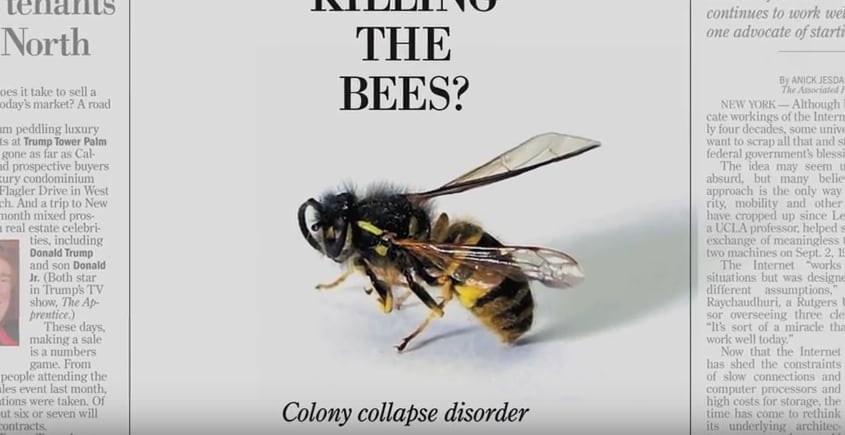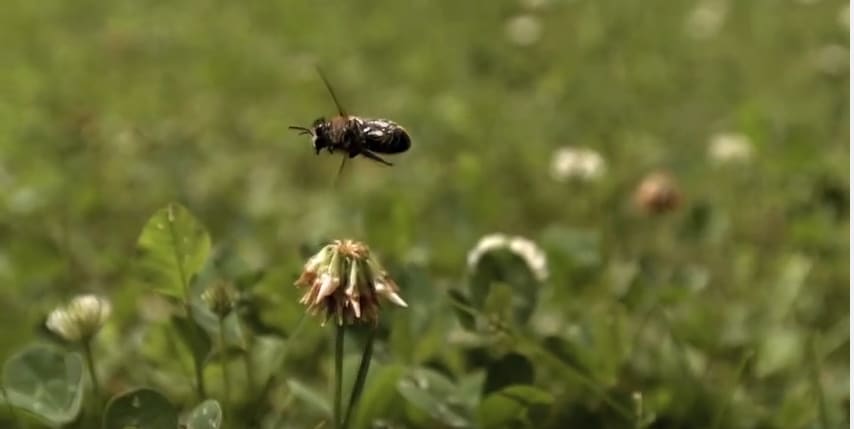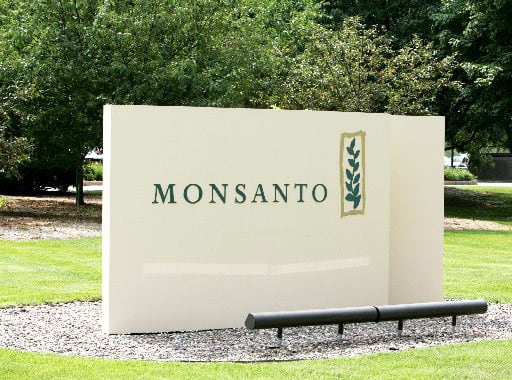モンサントのやっていることは、
所詮、生物絶滅作戦であって、
行く行くは人間に降りかかる・・・!
トウモロコシの種に殺虫剤をコーティングしているからだ、
と書いてある。
それが種まき機エアシーダーに依って、
空中拡散したためにミツバチが大量に死亡した・・・。
それだけだろうか?
GMOであれば、
殺虫成分を分泌する種子のはずだ。
その植物の花粉・蜜を摂取してミツバチが死ぬ?!
ってことも考えられる。


今、
恐ろしい事が進行していると考えない訳には行かない。
因みに、
輸入穀物には、
ポストハーベストといって、
殺虫剤が混入されている。
それが無いと船倉で穀蔵虫が発生するからだと言われる。
それを、
人間は食べることになる。
あるいは、
加工食品の多くは輸入穀物である。
飼料はほとんど輸入トウモロコシだ。


ミツバチが死ぬということは、
生体系の植物の受粉に甚大な影響をもたらす。
昨今のミツバチの激減や、
その死亡の原因の一つにGMO種があったとは、
初耳である。
いろいろ考えられる。
ケムトレイル散布もその一つだろうと考えた来た。
モンサントは、
ケムトレイル毒物も供給していると聞く。
やること為すこと一貫している・・・。
人口削減・・・。
ジョージア・ストーンに書かれていることに忠実だ、
と言えば、
その仲間であることは間違いない。


食料を制するものは、
世界を制する・・・と考える輩は、
まずは種子、益虫、農業システム、食料・・・
と実に戦略的だ。
又、
パンデミック、ワクチン、不妊、
免疫不全のタイムトリガー・・・と、
搦め手で各方面からやってくる・・・。
実に手ごわい相手である。
いや、しつこい相手である。
Vanishing Of The Bees - Official Trailer
【転載開始】
37 Million Bees Dead After GMO Seeds Planted Nearby

Over 37 million bees have been found dead in Canada after GMO corn was planted recently in the local area.
According to local beekeeper, Dave Schuit, since the GMO corn was planted close to his farm he lost over 37 million bees as a direct result.
Anonhq.com reports:
According to reports, Schuit and other local beekeepers believe neonicotinoids, or “neonics” are to blame for the influx of bee deaths.
Around 37 million bees at a farm in Canada have died after GMO corn was planted in the nearby area, according to a local beekeeper.
Dave Schuit, a beekeeper who produces honey in Elmwood, Canada, claims that since GMO corn was planted in the nearby area, his farm has lost around 37 million bees (approximately 600 hives). According to reports, Schuit and other local beekeepers believe neonicotinoids, or “neonics” are to blame for the influx of bee deaths.
Imidacloprid and Clothianidin, two of Bayer CropScience’s most widely used pesticide, both contain neonics and have been linked with many large-scale bee ‘die-offs’ in both European and U.S. countries. However, despite the dangers associated with the use of this chemical, the pesticides are still regularly used and sold on the market.
Despite their size, the impact bees have on the environment is almost unparalleled. In fact, bees are responsible for pollinating about one-sixth of the flowering plant species worldwide and approximately 400 different agricultural types of plant.
In 2010, bees helped provide over $19 billion worth of agricultural crops in the U.S alone – estimated to be roughly one third of the food we eat. As a result, it is not hard to see that bees are needed to sustain our modern food system.
However, despite their obvious importance in our ecosystem, bee populations have been rapidly dropping over the past few decades. In fact, 44 percent of honeybee colonies in the United States died off last year, the U.S. Department of Agriculture reported last month.
In the past, scientists have tried to conclude why bee populations are in rapid decline. While it is not been proven that pesticides directly kill the bees that come into contact with the chemical, many scientists believe there is a strong link between the use of the pesticide and a phenomenon they refer to as “colony collapse disorder” (CCD).
“We believe that some subtle interactions between nutrition, pesticide exposure and other stressors are converging to kill colonies,” said Jeffery Pettis, of the ARS’s bee research laboratory.
While the cause of CCD is still widely debated, some believe that “the neonicotinoid pesticides are coating corn seeds, and with the use of new air seeders, are blowing pesticide dust into the air when planted.”
However, according to a new study published in the Journal Proceedings of the National Academy of Sciences, neonicotinoid pesticides kill honeybees by damaging their immune system and making them unable to fight diseases and bacteria.
Although we are unable to definitively determine what is causing the terminal decline of bee populations around the world, using all the scientific evidence that is currently available, it is clear that pesticides are having a significantly negative effect on bee populations.
In fact, it seems more and more countries are also beginning to accept this idea. Canada has banned the use of Imadacloprid on sunflower and corn fields; France has rejected Bayer’s application for Clothianidin; Italy has now banned certain neonicotinoids; and the European Union has banned multiple pesticides.
At this moment in time, EU scientists are reviewing the EU-wide ban on three neonicotinoid pesticides. By the end of January 2017, the EU scientist will finish their risk evaluation and determine the status of the chemical.
Although the United States have yet to follow suit, several states – including California, Alaska, New York, and Massachusetts – are currently considering legislation that would ban neonicotinoids. In fact, just last month Maryland came the first state to pass a neonic-restricting bill; Maryland’s Pollinator Protection Act has eliminated consumer use of neonicotinoids in the state.
【転載終了】
【Google仮訳】
近所に植えられたGMO種子の為に死んだ37百万ミツバチ
5コメント//サイエンス/環境でのショーンADL-Tabatabaiにより2016年6月20日に投稿されました
GMO種子が近くに植えた後3700万ミツバチが死体で発見しました
GMOトウモロコシは、ローカルエリアで最近植えた後に百万37以上のミツバチがカナダで死体で発見されています。
GMOトウモロコシが近い彼の農場に植えたので、地元の養蜂家、デイブSchuitによると、彼は直接の結果として百万37以上のミツバチを失いました。
Anonhq.comレポート:
報告によると、Schuitや地元の養蜂家は、ネオニコチノイド、または「neonicsは「ミツバチの死亡の流入に責任があると考えています。
GMOトウモロコシが周辺エリアに植えた後、カナダの農場で約3700万ミツバチは地元養蜂家によると、死亡しました。
Revcontentが主催
今流行っている
デイブSchuit、エルムウッド、カナダで蜂蜜を生産する養蜂家は、GMOトウモロコシが周辺エリアに植えられたため、彼の農場は約3700万ミツバチ(約600ハイブ)を失ったことを主張しています。報告によると、Schuitや地元の養蜂家は、ネオニコチノイド、または「neonicsは「ミツバチの死亡の流入に責任があると考えています。
イミダクロプリドとクロチアニジン、バイエルクロップサイエンスの最も広く使用されている殺虫剤の2、両方がneonicsが含まれており、ヨーロッパとアメリカ両国の多くの大規模な蜂「ダイ・オフ」とリンクされています。しかし、この化学物質の使用に伴う危険性にもかかわらず、農薬はまだ定期的に使用され、市場で販売されています。
その大きさにもかかわらず、ミツバチが環境に与える影響はほとんど比類のないです。実際には、ミツバチは、世界中の開花植物種の六分の一と植物の約400種類の農業種類について受粉する責任があります。
私たちが食べる食品のおよそ三分の一であると推定 - 2010年に、ミツバチは単独で米国では農作物のオーバー$ 19億ドルを提供助けました。その結果、ミツバチは、現代の食糧システムを維持するために必要とされていることを確認することは難しいことではありません。
しかし、私たちの生態系におけるその明白な重要性にもかかわらず、ミツバチの集団は急速に過去数十年の間に落下されています。実際、米国ではミツバチのコロニーの44パーセントは昨年オフに死亡した、農業の米国部門は先月報告しました。
過去には、科学者たちは蜂の個体数が急速に減少している理由を締結することを試みました。それは農薬が直接化学的に接触蜂を殺すことが証明されていないが、多くの科学者は、農薬の使用と、彼らは「蜂群崩壊症候群」(CCD)と呼ぶ現象との間に強い関連があると考えています。
「私たちは栄養、農薬暴露と他のストレス要因の間にいくつかの微妙な相互作用がコロニーを殺すように収束していることを信じて、「ARSのミツバチ研究所のジェフリー・ペティスは、言いました。
CCDの原因はまだ広く議論されているが、いくつかのことを信じている "ネオニコチノイド系殺虫剤は、トウモロコシの種子をコーティングしている植えられたとき、および新しいエアシーダーを使用して、空気中に農薬ほこりを吹いています。」
しかし、全米科学アカデミー紀要論文集に掲載された新しい研究によると、ネオニコチノイド系農薬は、その免疫システムに損傷を与える疾患および細菌と戦うためにそれらをできなくすることによってミツバチを殺します。
我々は決定的に現在利用可能なすべての科学的証拠を使用して、世界中のミツバチ集団の端子衰退の原因を特定することはできませんが、農薬はミツバチの個体数に有意な負の効果を有するものであることは明らかです。
実際には、より多くの国もこのアイデアを受け入れ始めているようです。カナダはヒマワリやトウモロコシフィールドのImadaclopridの使用を禁止しています。フランスはクロチアニジンのためのバイエルのアプリケーションを拒否しました。イタリアは現在、特定のネオニコチノイドを禁止しています。そして、欧州連合(EU)は、複数の農薬を禁止しています。
時間のこの時点では、EUの科学者は3ネオニコチノイド系農薬に関するEU全体の禁止を検討しています。 2017年1月の終わりまでに、EUの科学者は、彼らのリスク評価を完了し、化学物質の状態を決定します。
米国が追随するには至っていないものの、いくつかの州 - カリフォルニア州、アラスカ州、ニューヨーク、マサチューセッツ含む - は、現在、ネオニコチノイドを禁止する法案を検討しています。実際には、ちょうど先月メリーランドはneonic規制法案を通過させる第一の状態を来ました。メリーランド州の花粉媒介者保護法は、状態のネオニコチノイドの消費者の使用を排除しています。【Google仮訳終了】









